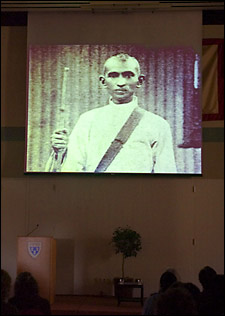Pacifism is fruit of family tree
Gandhi’s nonviolent principles show way toward peaceful world
The nonviolent principles of Mohandas Gandhi may be the only way to bring peace to the world, Gandhi’s granddaughter said Monday (Dec. 4).
Human rights activist and former South African member of parliament Ela Gandhi told about 160 people gathered in Harvard Law School’s Pound Hall that violent victory sows the seeds of its own destruction. It is only through nonviolent resistance and dispute resolution, the focus of Mohandas Gandhi’s Satyagraha philosophy, that the world can become a peaceful place, she said.

“It is the only way,” Ela Gandhi said, “in my opinion, and I hope I will convince you [of that] this afternoon.”
Gandhi was the featured speaker at a Program on Negotiation celebration of the centennial of the birth of Satyagraha. The principles were first espoused on Sept. 11, 1906, during a meeting of South African Indians upset at new legislation that would reduce their rights. That meeting began decades of work for social change through nonviolent means that would improve the lot of South African Indians and, ultimately, lead to India’s independence from Britain.
Susan Hackley, the Program on Negotiation’s managing director, said Mohandas Gandhi’s principles provided the foundation for later movements by celebrated leaders such as Martin Luther King Jr., Nelson Mandela, and Lech Walesa.
“The history of the last 100 years includes some breathtaking success stories … [by leaders who] brought about profound change without violence,” Hackley said. “All of these leaders would no doubt declare they owe a great debt to one person who 100 years ago developed a method and a philosophy for dealing with oppression that showed them how to stand up to overwhelming force.”
Hackley said that nonviolence and negotiation are commonly perceived as weakness, but that is not the case. William Ury, director of the Global Negotiation Project and co-author of books on negotiation including “Getting to Yes,” said that the South African Indians who came together to fight injustice in 1906 committed to much more than burning hated registration cards and refusing to comply with unjust laws.
“The power of collective will, the will to die but not to kill, was born that day,” Ury said. “The challenge is not just getting to ‘Yes,’ it’s saying ‘No.’ ‘Yes’ without ‘No’ is appeasement. ‘No’ without ‘Yes’ is war.”
Ury said the terminology surrounding negotiation has changed over the decades, but the principles remain those of Mohandas Gandhi: don’t react out of anger, put yourself in the other’s shoes, attack the problem not the person, and make it easy for the other side to say yes.
Ury summed up, echoing Gandhi saying he wanted to “bring the other side to their senses, not their knees.”
Ela Gandhi acknowledged that nonviolent resistance is easier said than done, however. It is instinctive to react to injustice with anger, she said. Those wanting to participate in nonviolent action need the courage to endure whatever physical and mental abuse they may face, and have to train themselves to control their urge to lash out. It also takes great love and a belief in the inherent goodness of people.
“In thought, word, and deed you have to be nonviolent,” Ela Gandhi said. “Anger is natural and instinctive.”
Satyagraha is not about winning, she said, but about reaching a mutual understanding that sows the seeds for lasting peace.
“Satyagraha paves the way for a peaceful life,” she said.
Her grandfather evolved from a man who liked expensive clothes to one who embraced simplicity, Ela Gandhi said. He faced his own fears – of snakes and of the dark – while living in South Africa. He led a highly regimented life, she said, with certain times of each day devoted to certain activities. It was a mark of how much he loved his grandchildren, she said, that even if officials were waiting, he would keep his appointments with them.
Ela Gandhi spoke about her own life as well as that of her grandfather, describing her involvement in the struggle against apartheid. She said she first demonstrated in an action against segregated college classes during her own graduation in 1958 and remained active through eight and a half years of house arrest in the 1970s, through the dismantling of apartheid where she worked with military leaders from both sides, and through her election as a member of the South African Parliament, where she sat from 1994 to 2004.
Communication was key, she said, because, although isolated action could be ignored, broad-based action demanded attention. The effort to defeat apartheid also benefited from the international support the peaceful activists received.
“That strength of people coming together brings about the changes we want to bring about,” Ela Gandhi said.
Related links:
- Candlelight vigil longs for peaceful world
- Ambassador hails Indian-U.S. partnership: Says nations share democracy, diversity
- Rally for peace




